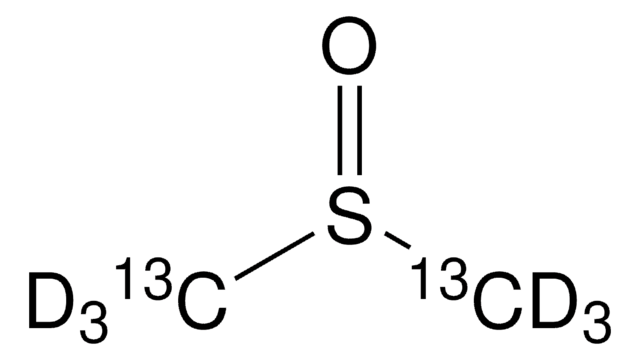156914
Dimethyl sulfoxide-d6
"100%", 99.96 atom % D
Synonim(y):
(Methyl sulfoxide)-d6, DMSO-d6, Hexadeuterodimethyl sulfoxide
About This Item
Polecane produkty
ciśnienie pary
0.42 mmHg ( 20 °C)
Poziom jakości
czystość izotopowa
99.96 atom % D
Próba
≥99% (CP)
Postać
liquid
temp. samozapłonu
573 °F
granice wybuchowości
42 %
metody
NMR: suitable
zanieczyszczenia
≤0.0250% water
water
współczynnik refrakcji
n20/D 1.476 (lit.)
tw
189 °C (lit.)
mp
20.2 °C (lit.)
gęstość
1.190 g/mL at 25 °C (lit.)
przesunięcie masy
M+6
ciąg SMILES
[2H]C([2H])([2H])S(=O)C([2H])([2H])[2H]
InChI
1S/C2H6OS/c1-4(2)3/h1-2H3/i1D3,2D3
Klucz InChI
IAZDPXIOMUYVGZ-WFGJKAKNSA-N
Szukasz podobnych produktów? Odwiedź Przewodnik dotyczący porównywania produktów
Opis ogólny
Zastosowanie
Polecane produkty
wyposażenie dodatkowe
Kod klasy składowania
10 - Combustible liquids
Klasa zagrożenia wodnego (WGK)
WGK 1
Temperatura zapłonu (°F)
190.4 °F
Temperatura zapłonu (°C)
88 °C
Certyfikaty analizy (CoA)
Poszukaj Certyfikaty analizy (CoA), wpisując numer partii/serii produktów. Numery serii i partii można znaleźć na etykiecie produktu po słowach „seria” lub „partia”.
Masz już ten produkt?
Dokumenty związane z niedawno zakupionymi produktami zostały zamieszczone w Bibliotece dokumentów.
Klienci oglądali również te produkty
Nasz zespół naukowców ma doświadczenie we wszystkich obszarach badań, w tym w naukach przyrodniczych, materiałoznawstwie, syntezie chemicznej, chromatografii, analityce i wielu innych dziedzinach.
Skontaktuj się z zespołem ds. pomocy technicznej

